Nature Now! Liking Lichens
For immediate release ‐ November 19, 2020
Nature Now
Contact: Jessica Wackes, 919.707.9850. Images available upon request
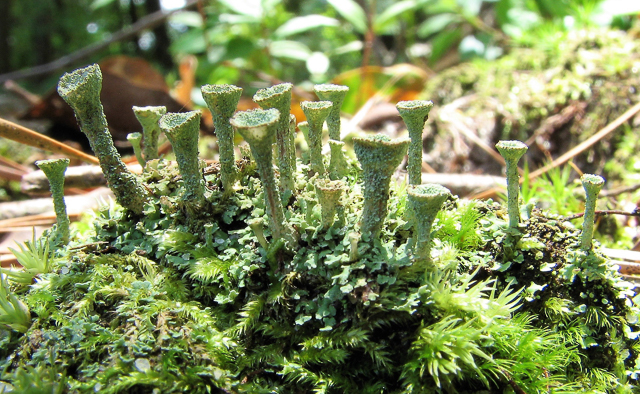 Pixie cups: a type of squamulose lichen.
Pixie cups: a type of squamulose lichen.
I like lichens! Anybody who has been on a hike with me knows that. I am quick to fall on my hands and knees to marvel at some lichen along the trail that most people would walk by and never see. I am not so quick to get up with my 60-plus-year-old knees, plus it takes time to appreciate the beauty and form of a lichen. I do not know the full identity of most lichens that I see but that does not diminish my enjoyment in seeing their diverse forms. Identifying lichens can be challenging as there are so many different species with differences that only a real lichenologist can tease out for an identification.
Labelling a lichen as a “species” also requires some out-of-the-box thinking as a lichen is not just one organism! A lichen is a combination of a fungus with an alga or a cyanobacteria, or both. This is a mutually beneficial relationship as the fungus provides a safe home for the alga and/or cyanobacteria which in turn provide food for the partnership through photosynthesis. The lichen is completely self-sufficient, only requiring sunshine to fuel its life. I liken this to an RV where everything is self-contained and just needs a place to park. The sun is the generator that keeps the RV functioning. Unlike the RV in which we must stockpile food, this lichen “RV” produces its own food.
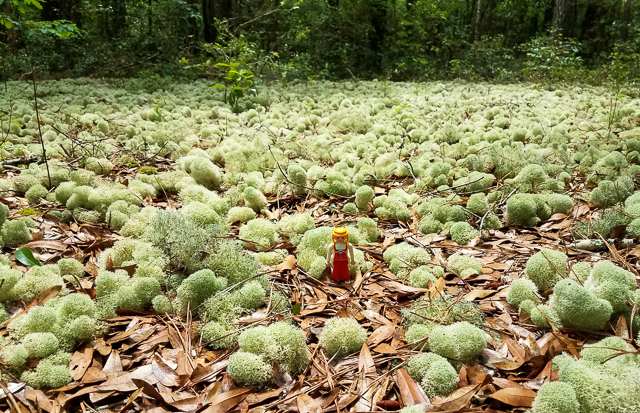 Field of Reindeer Moss lichens.
Field of Reindeer Moss lichens.
As far as where to “park,” the lichen can park almost anywhere! Lichens are the first to colonize on bare rock. I discussed this when I wrote about granite a few months ago and briefly talked about primary succession. Some lichens park on the ground or on stumps or dead logs where they compete for space with the mosses. Some just park on the top of the leaf litter. If a strong wind blows them to a new spot, no problem! Some even park on my house! I don’t pressure wash my house as often as I should, so I have lichens growing on the vinyl siding and asphalt roof shingles. The color of many tree trunks, particularly smooth-barked trees, is really the color of the lichens covering the trunks!
One of the best displays of lichens that I have ever seen in North Carolina was on the wooden boards of the goat fence at Somerset Place. The old fence was festooned with a wide variety of lichens. While other visitors were admiring the goats and history of the site, I was focused on the rich “lichenscape” on those old wooden boards. Somerset Place State Historic Site is nestled within Pettigrew State Park on the shores of Phelps Lake, North Carolina’s second largest natural lake. This is on the Albemarle-Pamlico peninsula which is a huge area bordered by the Pamlico River/Sound and the Albemarle Sound. This area of eastern North Carolina has been recently recognized as a hotspot of lichen diversity, attracting the attention of lichenologists and conservationists alike! The Southern Appalachian Mountains have long been known to be a hotspot for lichen diversity. North Carolina is blessed to have two such hotspots for lichen diversity, one on each end of the state.
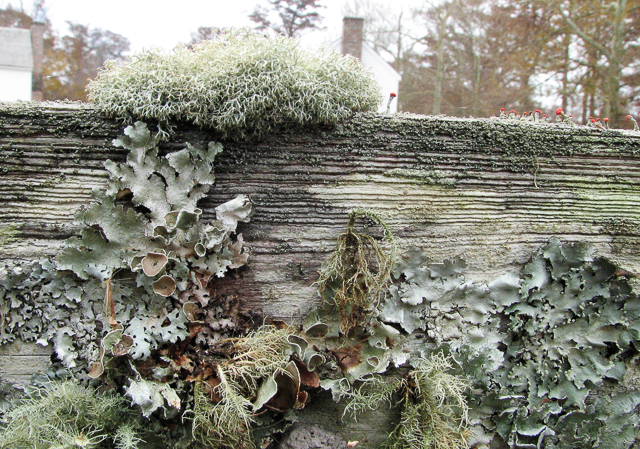 Lichen-covered fence board at Somerset Place.
Lichen-covered fence board at Somerset Place.
You don’t have to know the scientific names of lichens to appreciate their existence in our natural world. You can use the terminology used by lichenologists to describe the growth form of different lichens thus impressing your friends by “identifying” lichens on the trail. The three easiest-to-recognize forms of larger lichens are crustose, foliose and fruticose.
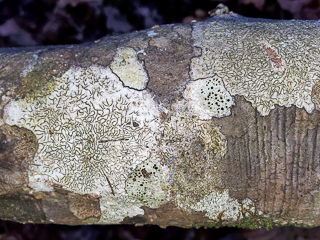
Crustose lichens on Ironwood Tree.
Crustose lichens look like they have been painted on. Find the smooth bark of a large American Beech tree and you will see a pattern of color patches on the tree with each shade indicating a different crustose lichen. You can even see the dark lines where the different lichens are in a “real estate battle” for space on the trunk!
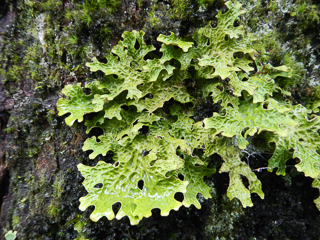
Lungwort, a Foliose Lichen in the Southern Appalachians.
Foliose lichens are those that are attached to a surface but with leafy edges.
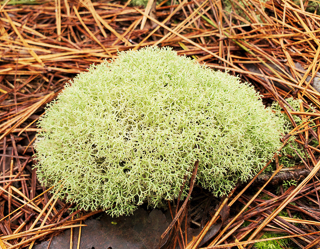
Reindeer Moss, a Fruticose lichen.
Fruticose lichens are those with a branching form like a tree or bush.
There are other growth forms, but these are the easiest to recognize and include many lichens commonly found. Lichens can reproduce just by breaking off the original lichen body and attaching on another surface (vegetative reproduction). But they also reproduce by spores. The spore-producing bodies on lichens vary tremendously, creating many wonderful shapes and colors on an already unique lichen form.
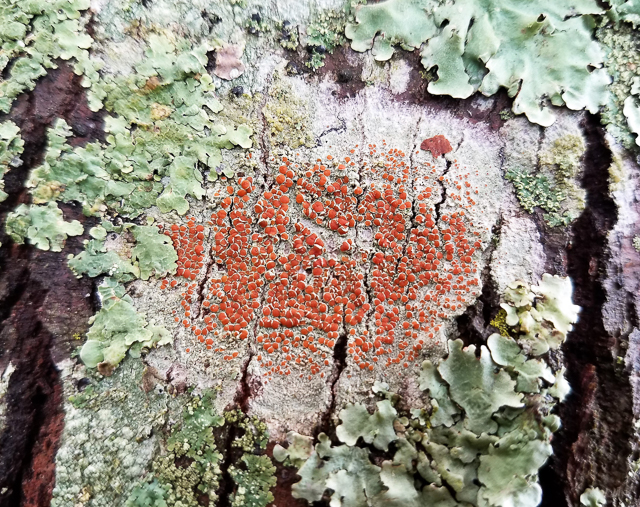 Crustose Lichen with red spore bodies surrounded by Foliose lichens
Crustose Lichen with red spore bodies surrounded by Foliose lichens
Lichens are a wonderful part of our biological diversity and you don’t have to go far to enjoy their incredible forms. Just go outside and pick up a branch fallen from a nearby tree. You might be surprised by the diversity of lichens on that one small branch. Look closely at the trunk of a tree in your yard or nearby park. You may find a rich assemblage of lichens and mosses competing for the tree’s real estate. I am only able to cover the surface of the incredible diversity and biology of the lichen world in this short blog post. But I hope that you will explore some of those lichen-covered surfaces and will learn more about these fascinating multi-organism life forms.
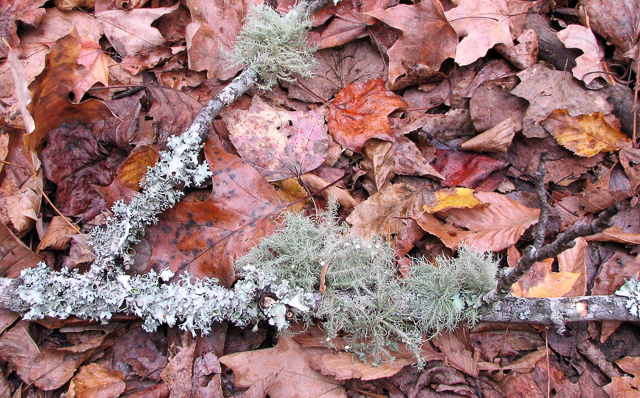 Foliose, Fruticose and Crustose lichens on a fallen tree branch.
Foliose, Fruticose and Crustose lichens on a fallen tree branch.
I like lichens! And I hope that you liked learning a little more about lichens!
Jerry Reynolds, Head of Outreach

